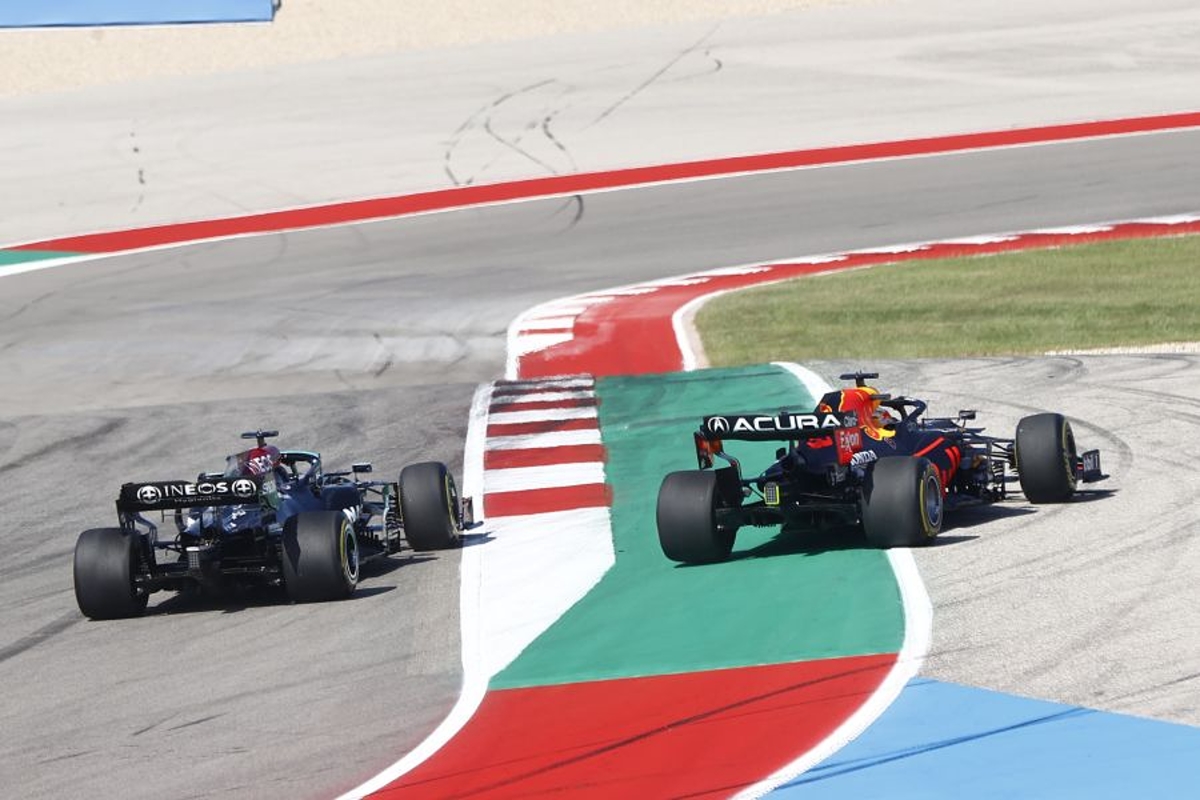Mercedes motorsport strategy director James Vowles has revealed how a Red Bull gamble with Max Verstappen proved decisive in his United States Grand Prix victory over Lewis Hamilton.
A thrilling race at the Circuit of the Americas was decided on the strategies of the two teams that culminated in Verstappen beating Hamilton by 1.333secs to extend his lead in the drivers' championship to 12 points with five races remaining.
Despite starting on pole position, Verstappen was beaten into the first corner by his F1 title rival but in keeping the Briton in touching distance, Red Bull pulled the trigger early on the first pit stop to reclaim the lead after Hamilton eventually pitted.
Red Bull then took another chance midway through the race by again coming in early for Verstappen's second stop and opting to go long on hard tyres.
Mercedes kept Hamilton on track for a further eight laps with his second stint, hoping the additional life in a fresh set of tyres would pay dividends at the end of the race.
Although Hamilton closed down an 8.8secs gap after his second stop to get within a second of Verstappen on the penultimate lap, he was never in a position to make a move for the win.
Explaining why Hamilton did not stop early given the power of the undercut, Vowles said: "It is always a trade-off between stopping early in terms of the traffic behind you and not running out of tyres before the end of the race. In other words, optimising your stints.
"The fastest two-stop race is actually stopping around about 14 or 15. So anything you are doing shorter than that is costing you race time and is making the entire race slower.
"Now, that may not matter as long as you have track position. Stopping where they did on lap 10 is clearly a compromise, but they obviously were very, very quick.
"On that first stint of the race on the medium tyre, we had Verstappen seven-tenths [of a second] behind us all stint and we were degrading quite quickly.
"What that means is you don’t have certainty that the hard tyre was going to be much different to that and you are trying to predict forward how the hard tyre will perform.
"You saw with Verstappen, he ran out of tyres on that second stint and he ran out of tyres end of the race. What they did was to a certain extent a gamble. They were in second position anyway so why not take some risks?
"The reason for us not stopping that early on is twofold. First, we would have come out right on top of [Daniel] Ricciardo.
'We would have been compromised through the Esses until we got past him probably on the run down to turn 12 and that would have cost us time. Maybe not enough to not hold on to that lead position but it would have cost us time.
"The second is, Red Bull would have then gone very long, as we did, but they did have two cars so they didn’t have the pressure to then stop and they were fast on that first stint on the medium and that could have made us into a very compromised position later in the race.
"So, from our perspective, we knew the early stop was good and we had highlighted that the lap Ricciardo pulled out of our window, which probably would have been lap 11, would be the right point but what Red Bull did was take a gamble.
"They didn’t mind if they had to convert to a three-stop - ultimately Verstappen would have finished second anyway - but we did. That would have put us behind [Sergio] Perez.
"So, ultimately, it’s a balance between making sure your first stint is long enough, that you are not dropping off the tyre curve on stint two and stint three because a team that can go longer than you will ultimately beat you if they have car pace."
Red Bull running one and three with Verstappen and Perez forced Mercedes' hand, and while Vowles concedes there were other options on the table, the same result would have materialised.
"Another decision point in the race is whether or not we could have aggressively undercut Red Bull on stint two of the race," added Vowles.
"Verstappen was just over three seconds ahead and the answer to that is, it was very marginal, but we had highlighted that the undercut wouldn’t be enough.
"If we were to stop, they will cover us the next lap and Lewis will still end up in P2 but now you have lost all tactical options because both cars were on the same stint to the end of the race.
"So, we had decided that our best opportunity was to force them in, or if we can get within two seconds we’ll go for the undercut.
"That didn’t happen, Verstappen stopped, and the rest is history.”
Related

































 Grand Prix of Australia 2025
Grand Prix of Australia 2025  Grand Prix of China 2025
Grand Prix of China 2025  Grand Prix of Japan 2025
Grand Prix of Japan 2025  Grand Prix of Bahrain 2025
Grand Prix of Bahrain 2025  Saudi Arabian Grand Prix 2025
Saudi Arabian Grand Prix 2025  Grand Prix De Monaco 2025
Grand Prix De Monaco 2025  Gran Premio de España 2025
Gran Premio de España 2025  Grand Prix du Canada 2025
Grand Prix du Canada 2025  Grand Prix of Austria 2025
Grand Prix of Austria 2025  Grand Prix of Belgium 2025
Grand Prix of Belgium 2025  Grand Prix of Hungary 2025
Grand Prix of Hungary 2025  Grand Prix of Azerbaijan 2025
Grand Prix of Azerbaijan 2025  Grand Prix of Singapore 2025
Grand Prix of Singapore 2025  Gran Premio de la Ciudad de Mexico 2025
Gran Premio de la Ciudad de Mexico 2025  Grande Prêmio de São Paulo 2025
Grande Prêmio de São Paulo 2025  Qatar Grand Prix 2025
Qatar Grand Prix 2025  Grand Prix of Abu Dhabi 2025
Grand Prix of Abu Dhabi 2025 